Column: Pass Go, Collect Bus Pass – And More?
In my wallet I have a transit pass. By sliding this pass through the farebox card reader aboard any Ann Arbor Transportation Authority bus, I get access to a public transportation system that served our community with 6.3 million rides this past fiscal year.
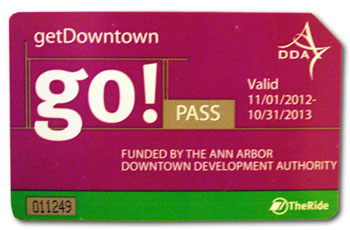
This go!pass, subsidized by the Ann Arbor Downtown Development Authority, lets its holder ride AATA buses an unlimited number of times.
If I rode the AATA buses to and from work every day and paid the full $1.50 fare each way, the cash value of that card would be about $750 per year. Of course if I were actually riding the bus that frequently, I’d be somewhat better off purchasing a 30-day pass for $58 a month, which would come out to just a bit under $700 annually.
What I actually paid for that card this year was $10 – just a bit over 1% of its potential cash value.
So what sort of dark magic subsidizes my potential rides on AATA buses? And why do I have access to this magical go!pass card, when you, dear Chronicle reader, likely do not?
Along the road to answering these questions, I’d also like to make a proposal. It’s a vision for broadening the program, getting more transit passes into the hands of Ann Arbor residents, and expanding the possible uses for the go!pass – including (shudder) the ability to use a transit pass to pay for parking.
Policy Choices Already Made: Charge More for Parking
A cynical explanation of my public transportation subsidy would go like this: On average, the unwitting motorists who park their cars in Ann Arbor’s public parking system pay prices set 3% higher than necessary; and this 3% “surcharge” is used to subsidize the bus rides of go!pass holders.
The percentage is basically right – because Ann Arbor’s public parking system generates about $15 million in revenue annually, and the annual subsidy required to pay for the rides taken by go!pass holders is about $500,000. And that $500,000 is, in fact, allocated from the fund that receives parking revenues.
But before you conclude that bus riders are benefiting at the expense of motorists, it’s worth considering the benefit to motorists from this subsidy: fewer cars on the road, which means better traffic flow for motorists; less competition among motorists for parking spaces; and reduced need to reserve for capital replacement and new construction of parking structures, which relieves some upward pressure on parking prices.
And if you’d like to argue against the go!pass transportation subsidy on the grounds that this “surcharge” on parking prices is effectively a tax – one that we voters never approved – then it’s worth considering that the total “surcharge” applied by the Ann Arbor public parking system is actually closer to 20%, of which only 3% goes to subsidize transportation. The other 17% is baked right into the contract with the city of Ann Arbor, under which the Ann Arbor Downtown Development Authority operates the city’s public parking system.
Under the terms of that contract, the city receives 17% of gross parking revenues, which the city uses to “subsidize” various general fund activities – like the salaries of police officers, firefighters, city planners, and allocations to human services nonprofits.
So when mayor John Hieftje talks about how he wouldn’t trade Ann Arbor’s budget situation for that of any other city in Michigan, it’s easy to understand why: Dealing with tight financial times is easier when you can cover the first 2% or so of your general fund budget with revenues from your public parking system. Other cities in Michigan don’t necessarily have the option to cover a general fund budget gap through increased parking prices.
In any case, I think it’s sound public policy to analyze the subsidy provided for go!passes as an investment in the city’s transportation infrastructure. I think it’s less sound to treat the public parking system as a way to backstop the general fund.
But my point in writing is not to argue the merits of either policy choice. Those policy choices are already currently in place. What I’m suggesting is that now is a good time to reflect on the specifics of how the transportation subsidy is allocated.
How Is the Transportation Subsidy Allocated?
The go!pass program is administered by getDowntown, but the entity that makes the policy choice on allocation of the go!pass subsidy is the board of the Ann Arbor DDA. That’s a function of the fact that the DDA manages Ann Arbor’s public parking system under contract with the city. And in broad strokes, as long as the city gets its contractually obligated 17% of gross revenues, the DDA has latitude to expend parking system revenues according to the collective wisdom of its board.
For around 10 years, a transportation subsidy has supported the go!pass program, which is available only to Ann Arbor downtown employees. I get my go!pass card through the Workantile, a downtown coworking community.
At its June 2, 2010 meeting, the DDA board made a three-year allocation from the parking fund for the go!pass subsidy: $445,672 for FY 2011; $488,054 for FY 2012; and $540,060 for FY 2013, the current year. This money is paid to the AATA to cover the cost of rides that go!pass holders take. The size of that subsidy is a function of at least two factors.
First, go!pass holders take a lot of rides on AATA buses. During the 12 months between Oct 1, 2011 and Sept. 30, 2012, they took about 604,000 rides. That reflected a slight dip in go!pass ridership, down from 634,000 rides in the previous year.
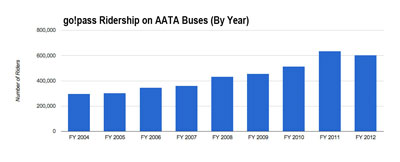
go!pass total rides by year. The number of rides taken with go!passes has roughly doubled since 2004. This past year reflected a dip, which appears to be related to a reduced number of cards in circulation: 6,591 compared to 7,226. (Data from AATA; chart by The Chronicle.)

go!pass rides by month, year over year. The red trend line is the most recent year, 2012. The previous year is shown in black. (Data from AATA; chart by The Chronicle.)

While the total number of rides dipped slightly, the number of rides per card continued its upward trend. Since 2004, the number of rides per card has increased from about 60 to about 90. (Data from getDowntown program; chart by The Chronicle.)
The size of the needed subsidy is also partly a function of AATA policy. At its Aug. 24, 2011 meeting, the AATA board voted essentially to calibrate the cost of the go!pass rides to the amount of money the DDA had already allocated, instead of calculating the actual cost, which would likely have been more.
The size of the subsidy that’s needed to support bus rides taken through the go!pass program is also reduced somewhat by the $10 cost that’s charged to a company for each employee’s go!pass. And a go!pass program rule further amplifies the effect of the $10 cost per go!pass. That rule requires participating downtown employers to purchase passes for all their employees – at a cost of $10 a year. So companies are required to be “all-in” with the go!pass program.
Say a 20-person company participates in the program, but only five employees think they’ll ever want to ride the bus, for whatever reason. That 20-person company is still required to purchase 20 go!passes at $10 apiece. The $150 collected for those 15 go!passes – which will likely never be used – helps offset the cost of the rides taken with the five other cards, which could be heavily used.
From presentations I’ve seen getDowntown executive director Nancy Shore give, the Workantile’s pattern of go!pass usage is typical. A few card holders take a relative large number of rides, while the “long tail” of cards shows relatively little use:
So the financial effect of the “all-in” requirement is to reduce somewhat the amount of additional subsidy that is needed, with the cost of little-used cards partly offsetting the cost of the rides taken with heavily-used cards.
But the “all-in” requirement is not financially motivated. Instead, it’s seen mainly as a way to put a bus pass in the hand of someone who might otherwise never even consider using the bus to get somewhere. And that person might wind up taking a couple rides, and might even add the bus as an occasional option to satisfy their travel needs.
That makes sense to me – putting a convenient, economical tool for accessing public transportation in as many hands as possible, on the theory that it might help win some converts. Some of those converts might add to the nice meaty head of the “long tail,” but others might help shorten and thicken up that tail.
With that in mind, why do those hands we’re putting these bus passes in have to be attached the ends of arms belonging to downtown employees?
Bus Passes for Everyone
I would make two observations. First, the go!pass program is a success measured in terms of participation and ridership. But I think the subsidy is greater than it needs to be to achieve the goals of the program. I think there’s a lot of room to increase the $10-per-card cost, without diminishing the fact that these go!passes would still be an incredible bargain to a cardholder or to a company. But some revision to the “all-in” requirement for downtown businesses might be required.
Second, ordinary Ann Arbor folks who own property and pay the 2 mill transit tax are susceptible to the same incentives and influences that downtown employees are. If you put a convenient, economical tool for accessing public transportation in all of their hands, you might make converts to public transportation out of them as well.
The DDA board will, between now and April 2012, weigh the question of continuing to support the go!pass program – because the three-year allocation goes only through this fiscal year, which ends on June 30, 2013. If the board were to maintain the public transportation go!pass subsidy at roughly current levels – around a half million dollars a year – but reduce the public transportation subsidy just for downtown employees, that subsidy could be extended to a broader group of people.
So here’s what I’d like the DDA board to consider: Begin a transition from the DDA’s historical approach to the go!pass subsidy, which is downtown-employee centric, to one that is more broadly inclusive of Ann Arbor. I’m not suggesting that we pull the rug out from under the go!pass program all in one go. But eventually, I’d like to see the following kind of program replace the current go!pass.
- A physical swipe-able transportation card would be sent to every Ann Arbor address that pays property taxes – because the card would be included in the tax bill. Any registered voters who were missed in that mailing would also receive a card. Having such a card would simply be part and parcel of living in Ann Arbor. They’d be as ubiquitous as library cards. Such cards could also be obtained by any non-resident for, say $10.
- The transportation cards would be issued in a “pre-loaded” state with, for example, 20 bus rides or 10 hours of parking. You could swipe it to board a bus, or to pay for your downtown parking. So this subsidy would be available broadly, not just to downtown employees. But it wouldn’t be as generous as the current subsidy to downtown employees.
- Additional value could be loaded onto the cards though online purchase or at automated kiosks at the downtown AATA transit center, which is being rebuilt. To make the kiosks a reality, though, the AATA would need to re-think some choices on that new transit center building it’s starting to build. At its Oct. 18, 2012 meeting, the AATA board opted to add the cost of LEED certification to the budget of the new transit station, but not to include the cost of automated ticketing kiosks.
The DDA board will be holding a retreat on Nov. 16. That would be a good occasion to engage in the higher-level policy discussion that could lead to such a transit pass program, funded with public parking revenues.
Other Ridership
Though it’s unrelated to my specific proposal, this column seems like a good repository for some additional data on other subsets of AATA ridership (University of Michigan affiliates) and other modes of transportation (Amtrak). So here it is:
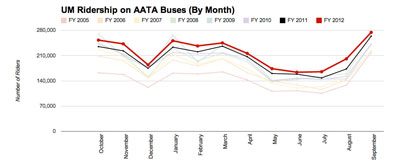
University of Michigan ridership on AATA buses by month from 2005-2012. The most recent year is the red trend line. The previous year is the black trend line. (Data from AATA; chart by The Chronicle.)
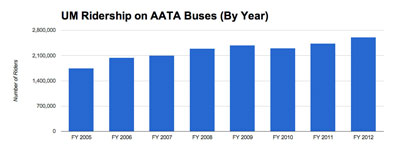
University of Michigan ridership on AATA buses – yearly totals: 2005-2012. (Data from AATA; chart by The Chronicle.)

Total ridership on AATA fixed route service by month from 2004-2012. The most recent year is the red trend line. The previous year is the black trend line. (Data from AATA; chart by The Chronicle.)
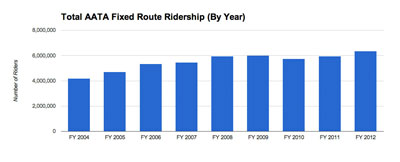
Total ridership on AATA fixed route service yearly totals from 2004-2012. (Data from AATA; chart by The Chronicle.)
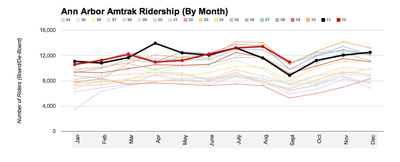
Total boardings and deboardings at the Ann Arbor Amtrak station, located on Depot Street. The most recent year is the red trend line. The previous year is the black trend line. Last year the monthly totals showed Amtrak on pace to set a record through May, but numbers dropped from May through the rest of the year, when compared to the previous year’s highs. This year tracked about the same as last year through March, dropped, but recovered in June and July and was back to previous years’ highs in August and September. (Data from MDOT; chart by The Chronicle.)
The Chronicle could not survive without regular voluntary subscriptions to support our coverage of local issues like transportation. Click this link for details: Subscribe to The Chronicle. And if you’re already on board The Chronicle’s bus, please encourage your friends, neighbors and colleagues to help support The Chronicle, too!





Dave,
Thank you for a thought provoking article. We are always trying to think of ways to expand the value of the go!pass program and have considered adding parking as part of the package. Essentially, working with the DDA to provide a reduced parking cost for employees who also use transit with the go!pass.
And yes, the $10 per employee cost might seem minimal, but it does depend on the company. For a 200 person company, increasing the cost of the go!pass even to $15 per employee might make it unpalatable, especially since it is an “all-in” approach. I think some of our decrease in ridership this past year might have been due to some employers dropping out because we increased the price of the pass to $10 per employee when it used to be $5 per employee.
This does not mean we wouldn’t ever consider an increase, we just want to make sure what we do will continue to make it easy for employers to take advantage of the program.
In terms of offering something like a go!pass to residents and employees outside of Ann Arbor, that has definitely been discussed by the AATA and there are some companies that do provide some go!pass like subsidy or discount so their employees can use the bus (such as WCC, UM, EMU).
Anyway, some good food for thought in this article. I look forward to seeing you at the DDA retreat and will be very interested in what they have to say.
Anyone with any thoughts or questions about the go!pass program, please feel free to contact me at nancy@getdowntown.org
–Nancy
Please note that all bus fares are heavily subsidized by federal, state and local taxes. That $1.50 is a small portion of the actual cost of a ride. In spite of the great subsidization of transit rides, only about 8% of local trips are made using transit.
The go!pass subsidy makes some sense if you consider the high price of building more parking downtown. Even parking lots that are not as “beautiful” as the underground lot adjacent to the downtown library, are expensive. Getting downtown employees to use transit saves on the cost of further construction. Unfortunately, not all trips in a car can be replaced by a bus trip to downtown.
One of the problems with local transit is the system design is based primarily on trips to and from downtown. Not everyone is going downtown. For example, the 1.5 mile trip from my house to Plum Market takes about 5 minutes in a car but takes more than an hour on the bus, including transferring from one route to another downtown. Even if I had a free pass for the bus, I would not use it for the kind of travel I actually do – to and from nearby merchants and such.
The other problem with attempting to induce more use of transit is the infrequent service and short hours. If your trip to work includes a stop at your kid’s day care or school, you have to add a half an hour wait for that next bus. If you work at a location across town and need to be there before 7:00 am, your need to transfer from one route to another will likely make it impossible.
If you work a second shift (ie: 3:00 to 11:30 pm) you will not have a bus ride home at the end of your day. And if you need weekend service, you are in real trouble.
Our current transit service best serves those going downtown and back for 9 to 5 work schedules. The go!pass subsidy properly focuses on that kind of transit. Putting a pass in the hand of every taxpayer would merely remind most of them how the current routes, frequency and hours do not serve the needs of most of us.
I have a free pass. Thanks to the beneficence of AATA’s fare structure, I have a pass that lets me ride on all ordinary routes for free, because I am a senior. (There was good reasoning behind the issuance of this, namely to get seniors to ride the bus instead of using demand services.)
In spite of this very good deal, I only ride the bus to downtown meetings or very rarely for entertainment downtown. Why? Just as Jack says, you can’t get most places from here very easily. Further, my bus service cuts out on evenings and weekends.
Thanks for this nice dense, chewy column. Much to think about.
How are volunteers treated? Are they considered employees? There are several organizations downtown that rely on volunteers. Often the volunteer roster is many hundreds of people. This coupled with the “all-in” policy makes it very expensive for a volunteer organization to subscribe to the Go Pass program.
In comment (2) I noted that the impediment to increased transit use is not price, but utility. That utility does exist for transit passengers who work downtown, Monday to Friday, 9 to 5. But, encouraging downtown employees to use transit rather than individual vehicles might have a detrimental impact on City finances.
We currently have a surplus supply of downtown parking. The DDA is offering steep discounts for parking contracts in the new, very expensive, underground parking structure. Most of those new contracts probably replace parking in other lots and structures.
Our downtown parking system is burdened with considerable debt. Also, as you note, the City captures 17% of parking revenues, making our parking system an important source of revenue. If we divert drivers from paid parking spaces into buses, will we harm the DDA’s ability to afford its parking debt load and parking structure maintenance? Will we have an impact on the City’s budget if parking revenues decline?
Having overbuilt our downtown parking supply, we must be careful not to do anything that might have a substantial impact on parking revenues. The downtown parking system has become a cottage industry that is at odds with our interest in increasing transit use.
I started reading this column expecting a suggestion that we look at making the transit system free-ish to the rider (as it is to a go!pass holder) and paying for the current rider-borne share in other fashions. This could be a totally reasonable solution, based on, as you say, the general, community-wide social and economic benefits of people riding transit.
…But your final recommendation appears to just be for a swipe-card transit pass system that happens to come with a “first ride free” incentive (or 10 rides free, or what have you). I don’t think that’s a bad idea, and most major transit systems have durable, reloadable passes that come at some per-ride discount, but it doesn’t seem to me like the same thing as the go!pass.
And what would “other fashions” be? The AATA is already running on fumes and the suggested financial plan (which needs serious revisiting, given all the opt-outs) actually calls for a 50-cent across-the-board fare increase. Tax revenue seems unlikely to be able to fill the void.
I think the go!pass system is a good sensible attempt to get downtown workers to take the bus. As your charts indicate, the ridership has been increasing. I hope that the DDA will continue funding it.
Re (6), you refer to “the general, community-wide social and economic benefits of people riding transit.” This seems to presume that if only people would ride transit we could be free of polluting single passenger vehicle modes of transportation.
I can’t think of any community where transit has replaced traffic congestion. It is not a choice between everybody riding the bus or everybody stuck in traffic. Think of New York or Chicago. Both cities have transit systems that allow one to forgo car ownership and rely completely on public transit. Yet neither city is free of traffic congestion and both cities have high costs associated with parking. In the Washington D.C. area, each time the public transit service area expands, so does the urban sprawl.
In a small town like Ann Arbor, great transit would not replace individual vehicle use. Instead, it would allow unsustainable population growth. We could increase the city’s population without providing additional road capacity. Expanding the service area for local transit (such as with commuter rail or the “countywide” transit plan) would simply encourage further urban sprawl.
It is important to distinguish between the use of transit for wishful environmental reasons and the more likely result of massive urban growth. Do we want our town to grow into a new huge metropolis? That is what proponents are advocating when they speak of “transit oriented development”. They wish to increase the population of the area beyond the capacity of our roads. But in the process, the roads will remain full of traffic, just like any city with a good bus system. No reduction in pollution, no net social good – just growth.
There sems to be an almost universal opinion that increased transit use means decreased pollution.
I would argue otherwise.
From what I can gather of system-wide fuel use, the bus system is lucky to get 10 passenger miles per gallon. (Figures from other systems, AATA hasn’t responded to my requests for hard numbers). That’s the same as 1 passenger in a car getting 10 miles per gallon. In reality, I do twice as good as that in my 2 ton Lincoln. And most cars do even better. And, some cars have 2 or mor epeople inthem, making them better yet.
And those buses get their 10 passenger miles per gallon with one of the dirtiest engines around, the diesel. Despite “clean diesel”, buses spew out particulates, benzine, ring compounds, and all sorts of other nasty things. Modern cars are so clean that the exhaust is sometimes cleaner than the air they take in. In fact, it is now impossible to commit suicide with an modern car in a closed garage because a tank of gas will not create enough carbon monoxide to kill you, just leave you with a bad headache.
So, if we wanted to reduce pollution, it could be argues that we should retire the diesel powered buses and simply give everyone a new Ford Focus.
There are valid reasons for having a mass transit system, of course. Not everyone can drive, or wants to drive, and there are issues of parking, congestion, and land use.
But air pollution aint one of them.
Bob, where are your numbers from? They surprise me.
Ed,
Without addressing the accuracy of the information reported, I offer the following page as an example of those who question the “greenness” of transit: [link]
It addresses ITP, the 6 community transit authority in the Grand Rapids area.
What Bob forgets with his “give everyone a new Ford Focus” suggestion is that not everyone is able to drive.
Interesting. I wonder whether AATA has ever done a carbon footprint/emission study of their buses. They certainly have a lot of other data.
They have in recent years been buying a lot of hybrid buses. A comparison of both mileage and emissions would be interesting to see.
I’ll note that fixed-route buses are usually supplied only to areas with a certain population level. Obviously, every rider reduces the emission averages. Also, if we are to supply bus service to anyone at all, it is more efficient to encourage full usage of that bus. I watch two elderly neighbors of mine who do not drive and walk with assistance of a cane in one case. They make nearly daily trips downtown via our bus, often coming back with a little shopping bag. I’m glad it is there for them. We just need to utilize the bus well.
To me, one of the economic benefits of transit is leveraging federal dollars in order to relieve thousands of residents of the economic burden of owning a car (or owning an additional car). The social benefit is that this service, in theory, facilitates a community with a more mixed-income profile.
Transit-oriented development can refer to “densifying” areas that are already well-served by transit. Ideally, these places would allow some commercial services or be walkable to other amenities. And as many know, denser development that takes place within a district that is already served by water, sewer, roads, police, fire, etc. is a net benefit (financially) to a municipality, because any additional infrastructure and services can be provided at a much lower cost per capita, and the city benefits through increased property tax revenues relative to the smaller incremental cost of increased services. Since we are committed to providing transit service, many times this additional density will help “fill up” buses without requiring as many fare increases.
This is not a defense of park and rides (especially ones that don’t take advantage of existing empty pavement near commerce) or regional bus transit (when there’s still developable land within the city limits).
Mr. Eaton probably overlooked the 6th paragraph of my note, and probably the 7th as well.
There have to be better solutions to getting people around who cannot drive, or cannot own a car. Back in the days of Dial-a-ride, when the AATA buses were purple and green, part of the program was subsidized cab rides for elderly and handicapped. If we could break the mold of thinking about transit as a mass endeavor, and think about it in terms of actual energy use and usefulness to people, I’m sure we could come up better solutions.
Passenger miles per gallon are from a study of New York City’s bus system, about 10-12 years ago. Perhaps they do better now, but then, so do cars.
Hybrid systems in cars have about a 20% improvement in urban driving cycles, when all other variables are constant. I suspect the improvement in buses would be somewhat less because they spend so much time standing still with the air conditioning running.
For what it’s worth, the Ford Focus reference was intended to be a bit of irony. As was the reference to the 2 ton Lincoln: the Lincoln has since been replaced by a somewhat pretentious German car.
Bob
Ed, the US Department of Energy puts out the Transportation Energy Data Book, which is a good source for this kind of information. They give the average passenger load for private cars as 1.55, and energy per passenger mile as 3,538 btu (sorry about the arcane units). For buses, they give 9.2 and 4,242 respectively.
Even more surprising is that walking is less fuel efficient than driving if you factor in the fuel used to produce the food you eat. That’s not in the Data Book but I think I’ve got a reference around here somewhere.
“Even more surprising is that walking is less fuel efficient than driving if you factor in the fuel used to produce the food you eat.”
That depends, somewhat, on how and where your food is grown. In general, though, wheels are very efficient for mobility.
It also points toward the technology trap known as Jevons’ Paradox wherein a focus on energy efficiency tends to lead to greater energy consumption. This is part of my concern about the library bond proposal, whose supporters point to greater energy efficiency as a good thing when it will actually result in higher overall energy use and higher energy costs, less than a decade before we reach the net energy cliff. (My other main concern is the deflationary depression of which we’ve only experienced the initial bump of a long, rough ride down.)
Here‘s an article on a French city that made their transit system free (without even an -ish). No clue as to whether that would work with our current system of funding–I suspect not–but I found it interesting nonetheless.